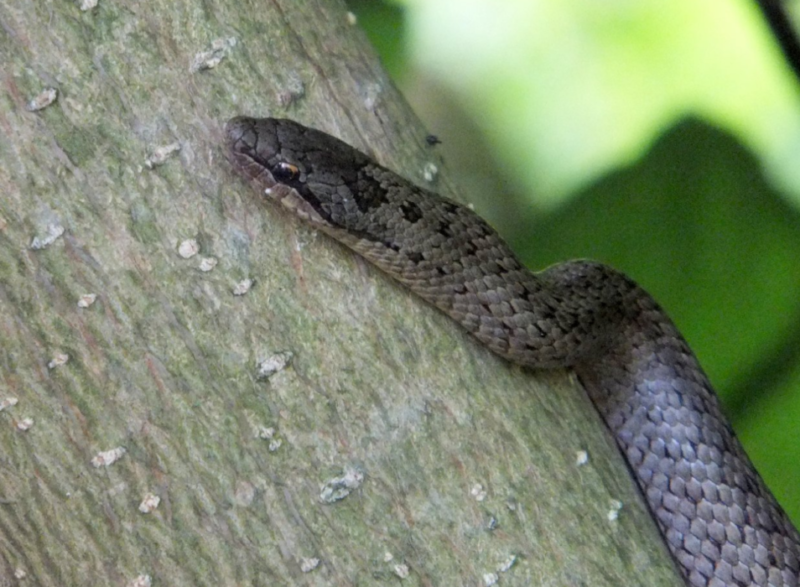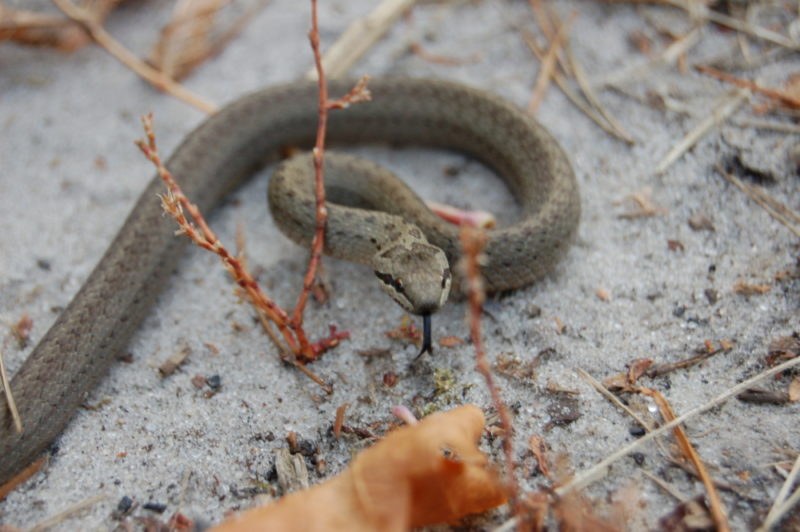The snake, which causes a lot of controversy and fears, is modestly called ordinary copperfish. It is often confused with a poisonous viper or with a legless lizard. But, it turns out, these are three completely different animals with their own characteristics of life and external differences.
Material Content:
Description and features of the species
An ordinary copperfish among herpetologists is called Coronella austriaca. It belongs to the family of the already distinctive and the genus of copperfish. The length of her body does not exceed 70 cm, but she has enough strength to easily catch small rodents and even some snakes.
The color of the snake is heterogeneous: the main color can be light gray or saturated, almost black. The animal got its name because of the bright copper abdomen and the reddish tint of the back. During the change of skin, the copperhead darkens, sometimes taking on a dark brown color.
Of particular interest are the eyes of the snake. They have a copper color to match the abdomen. Representatives of different sexes differ in color: females are closer to brown shades, and males are closer to red. Body color also depends on age. The younger the animal, the brighter it is.
Important! The spots on the body of snakes are not always framed in the pattern.
They may be pale or absent altogether, which does not give reason to relate the snake to another species. In most, the color is characterized by lines and spots of dark brown or black.
Copper snake differs from a viper in several ways:
- its head is flat in shape and practically combined with the body, in contrast to the clear separation of these parts in the viper;
- shields on the head are large, and the viper is small;
- the surface of the scales is smooth and shiny, while the viper has an uneven surface;
- her pupil is round in shape, as opposed to vertical in the venomous snake;
- there are no teeth on which the poison flows, while the viper has them.
The copperfish is a non-toxic snake, which is due to the structure of its jaw and the characteristics of the body. All the beliefs associated with her arose due to the fact that she was confused with a dangerous viper. But she herself is harmless already - after her bite, an unpleasant sensation of burning or itching remains, but there is no big wound.
Attention! It is still worthwhile to see a doctor - snakes can carry infectious diseases.
And for small rodents or small cold-blooded animals, a bite of a copperfish can lead to death.
Lifestyle & Habitat
Due to the lack of ability to regulate body temperature, snakes love heat. They live in places where the sun warms the earth well - in glades and in meadows. In fine weather, animals crawl out of their holes and relax in the open air. And at night they sleep in a dwelling, because their metabolism and speed of movement slow down due to low air temperature.
Coppers try to find one nest for life. They can live in rodent burrows, crevices of rocks, under rocks or in decaying trees. If nobody breaks the house of the snake, it will remain in it until it dies.
These snakes do not live in families. They violently protect the home even from individuals of the same species. During the mating season, coppers mate and then diverge. Only the female takes care of the offspring. When any animal representing a danger appears nearby, the snake pounces on it, kills and eats (if its size allows).
Coppers have a low speed of movement. Therefore, they do not catch up with prey, but wait for it, hiding. In this state, the snake can lie for quite some time. When a victim passes by, she pounces on her and captures her. The animal caught by the animal holds so much time that it stops breathing. Then the food is swallowed whole, and the snake creeps out to digest it.
These animals do not like wet habitats. They try to avoid ponds, although they swim perfectly. This is due to the low temperature of the water, which is why the snake becomes quite slow.
The copper coin has a characteristic manner of behavior when attacking it. Her defense is to curl up in a tight ball and put his head in the center of it. So the opponent can not cause her significant injuries. Periodically, the snake makes a jerk at the enemy and again takes a defensive position.
These snakes do not attack humans because of aggression. They do so out of fear of a large and unknown being. Therefore, in the wild it is better not to approach them. And in the terrariums, coppers can behave very friendly and feed from the hands of people.
Habitat, habitat
Copperworms live in forests, but not more often, but in clearings and areas with a minimum number of trees. Its range is quite wide, but often it is separate individuals than the places of mass habitat. These snakes love warmth, therefore they are more common in the southern regions.
In European countries, this snake was found everywhere except Scandinavia, Ireland and the Mediterranean islands. A large number of individuals live in southern Asia and in the northwest of the African continent. In Russia, it is met in the southern regions, in Siberia and the central part (Kursk, Tula, Ryazan and Samara regions).
Giving preference to forests, copperfish can also settle on the slopes of the mountains. She lives in crevices or under stones. Since the snake does not have a potent poison, it tries to build a home in sheltered and secluded places.
Diet of ordinary copperfish
From the description of the type of snake, it is clear that the size of the body and the absence of potent poison do not allow it to hunt large animals. Therefore, it feeds on lizards and other small, cold-blooded animals. If their quantity is insufficient for food, the coppers will switch to small rodents - shrews and voles.
With a lack of food, snakes can eat small birds and newborn rodents. In some cases, coppers kill for the sake of feeding individuals of their own species. These animals are extremely voracious - they lack one victim for satiation. Often, several individuals are immediately found in the stomach of a dead snake.
Breeding and offspring
The activity of copperfish lasts only 6 months. The rest of the time it is too cold to move freely, so the snake is sleeping. For six months, she must conceive and bear offspring, so that in September and October, hide in the home until warm.
Mating time for these snakes comes in the spring. In some cases, copulation occurs in the fall. Then the male sperm are stored in the testicles of the female until spring, so that the offspring are born in the warm season.
At the time of intercourse, the male wraps her jaw around the neck of a female individual, and wraps her body around her body. After the end of the act, snakes never remain together.
Copperworms belong to ovoviviparous animals - offspring appear in the egg membrane, but are viable. Young at the time of birth are so developed that they are capable of independent life. In total, the female produces up to 15 snakes. They independently break through the egg shell and crawl out of it. Their length at this moment is about 17 cm. These snakes have no concern for offspring. Despite the independence of the cubs after birth, they reach puberty by only 3 years.
Life span
The maximum lifespan of copperfish in the wild is 15 years. But it is difficult for them to stretch 10 years, since the snake has almost no protective mechanisms and is extremely limited in nutrition. In the terrariums, coppers live much longer, since they lack enemies and create optimal conditions for existence.
Natural enemies
In addition to special defensive tactics, mimicry with a viper and the fetid secret of cloacal glands, the copperfish does not have protective mechanisms. Therefore, many representatives of the fauna eat it. First of all, hedgehogs, rats, martens, large birds and wild boars. Even small frogs can catch small newborn snakes; therefore, the number of coppers is quite limited.
Security measures
The number of these snakes is steadily decreasing. This is due to the prejudices and delusions of people, because of which the population is exterminated. But the main reason is that the copperfish eats lizards, the number of which depends on many factors: ecology, climate, food availability. This snake can eat other animals, but it will not be the main diet. Therefore, the number of copperfish directly depends on the success of the reproduction of lizards.
The snake is not included in the Red Book of the Russian Federation. But it was included in the regional issues of this publication in 23 regions and 6 republics of the country. In Ukraine and Belarus, copperfish is listed in the State Red Books and is protected by law.
The copperfish is one of the most interesting and phenomenal snakes due to its natural beauty and similarity with other species. It is harmless, but it causes a lot of fear due to people's prejudices. This is an endangered snake that needs to be protected and protected. Therefore, it is worth knowing its features and stop destroying it, confusing it with dangerous species. Indeed, the diversity of the animal world on our planet depends on this.



















